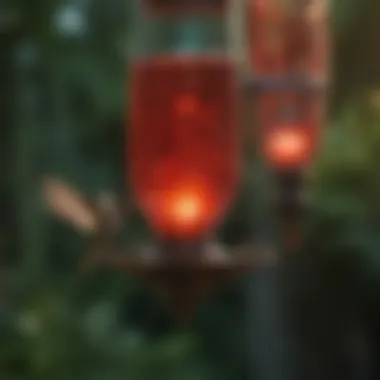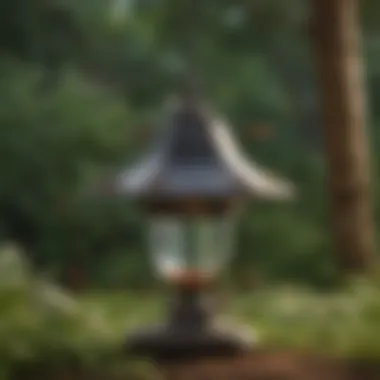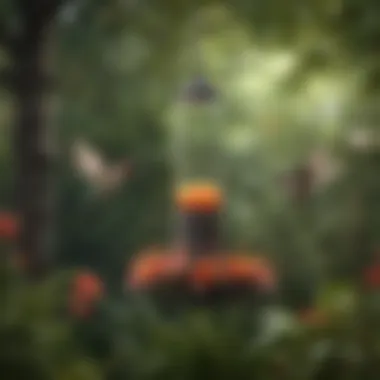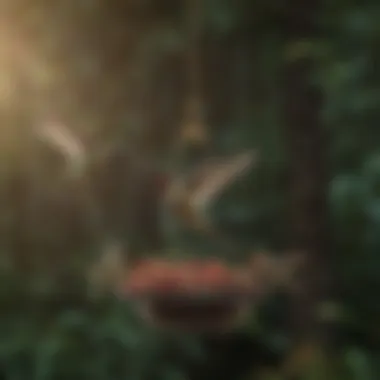Choosing the Best Hummingbird Feeder: Ant Deterrent Tips


Intro
Hummingbirds are a delightful addition to any garden. Their iridescent feathers and lively movements captivate birdwatchers and casual observers alike. However, one of the challenges that come with maintaining a hummingbird-friendly space is the persistent presence of ants, which can easily take over feeders.
In this guide, we’ll explore effective strategies for choosing the ideal hummingbird feeder that not only attracts these enchanting birds but also minimizes the risk of ant infestations. We'll delve into design options, materials, and best practices to help you establish an inviting and functional feeding station.
Design Inspiration
Designing a bird feeder that fits both your aesthetic and functional needs requires thoughtful consideration.
Trending Styles and Themes
When selecting a hummingbird feeder, it’s essential to consider the style that complements your garden backdrop. Contemporary feeders often showcase sleek lines and contemporary designs, while more rustic options may feature wrought iron or ceramic materials. Popular themes range from vintage looks that bring a sense of nostalgia, to modern minimalist aesthetics that offer a clean appearance.
Choosing a feeder that resonates with your personal style can enhance your garden's overall look. Whether you prefer whimsical shapes like flowers or more traditional clear glass styles, the availability is vast and varied.
Color Palettes and Combinations
Color plays a pivotal role in attracting hummingbirds. Bright, vibrant hues like red, orange, and yellow can catch their attention from afar. However, it’s equally important to avoid excessive patterns that may disorient the birds.
A thoughtful color scheme can also tie the feeder to other elements of your garden. Using colors that echo your flowers or foliage creates a cohesive look. For instance, if your garden blooms with purple petunias, consider feeders with complementary shades of pink or violet — it can produce a breathtaking visual experience while ensuring a welcoming environment for your feathered friends.
Gardening Advice
Setting up hummingbird feeders also has a connection with your broader gardening approach.
Seasonal Planting Guides
To create a habitat that supports hummingbirds, include native plants that bloom in sequence throughout different seasons. Early bloomers such as columbine or salvia can provide the first source of nectar after winter. Meanwhile, plants like bee balm or trumpet vine flower later in the summer.
It's essential to have feeders ready to fill in gaps between blooming seasons, ensuring that food is always available. Monitoring plant growth alongside feeder placement can create a more strategic feeding environment.
Maintenance and Care Tips
A well-maintained feeder ensures the health of not only the hummingbirds but also your garden’s overall ecosystem. Cleaning your feeder every two weeks is vital, especially in warmer weather when nectar can spoil quickly. Use a gentle soap and warm water, avoiding harsh chemicals that could harm the birds.
- Check for leaks: Ants are notorious for infiltrating feeders that aren’t sealed properly.
- Refill nectar regularly: Fresh nectar keeps hummingbirds coming back.
- Placement considerations: Avoid putting feeders near ant nests or pooling water areas.
"A little foresight in design and maintenance goes a long way towards creating a serene feeding environment for hummingbirds, while also deterring pesky ants."
Understanding the Importance of Hummingbird Feeders
Hummingbird feeders play a pivotal role in our gardens and ecosystems. They not only attract these colorful creatures but also contribute significantly to the overall health and biodiversity of our surroundings. As we delve into their importance, it’s essential to understand the ecological interactions that these charming birds foster. With the right feeder, hummingbirds can thrive, and in turn, enhance the liveliness of your garden.
The Ecological Role of Hummingbirds
Hummingbirds are more than just beautiful birds zipping around; they serve as essential pollinators in various ecosystems. With their long, specialized bills, they are adept at reaching the nectar deep within certain flowers, facilitating a symbiosis that fosters plant reproduction.


In many regions, these birds visit a multitude of flowers, thus enhancing their genetic diversity. This not only helps individual plants flourish but ensures overall plant health in the ecosystem. Imagine a world where multiple species intertwine through such relationships, all aided by these tiny avian acrobats. It’s a classic case of a mutually beneficial relationship, where hummingbirds get nourishment while the plants reproduce.
Why Feeders Enhance Biodiversity
Setting up hummingbird feeders in your garden is a proactive step toward attracting not only hummingbirds but a variety of pollinators and other wildlife. When established in a landscape rich in flora, feeders can help pull in diverse insects and even butterflies, which leads to a more vibrant ecosystem.
So, how do these feeders enhance biodiversity? Here are some key considerations:
- Diverse Flora: A well-placed feeder encourages various flowering plants nearby, fostering a blooming environment that supports multiple species.
- Increased Food Source: As hummingbirds visit feeders, they often bring along other species. This creates a food web that underpins local wildlife, enhancing overall biodiversity.
- Habitat Stability: Feeding stations can create microhabitats that attract smaller wildlife, such as beneficial insects, ultimately providing food for small birds and mammals.
"A garden with hummingbird feeders turns into a nexus of life, supporting a range of species that thrive together."
In summary, understanding the importance of hummingbird feeders goes beyond appreciation for beauty. They serve as a strategic tool that homeowners and garden enthusiasts can use to promote ecological health, support local wildlife, and create a more pleasing environment to enjoy. With the right approach, these feeders can be both an aesthetic and functional addition to your outdoor space.
The Problem of Ants at Hummingbird Feeders
Hummingbird feeders, while designed to attract these delicate fluttering creatures, often unwittingly draw in a much less desirable guest: ants. Addressing this issue is vital since an ant infestation can deter hummingbirds from approaching feeders, restricting their food sources and hurting their populations over time. As any experienced gardener knows, maintaining a harmonious ecosystem involves understanding these interactions and employing effective strategies to ensure the feeders remain a safe haven for hummingbirds.
Ant Behavior and Attraction to Feeders
Ants are relentless in their pursuits, driven by a keen sense of smell that draws them to sugary substances like those found in hummingbird nectar. Their foraging behavior is quite sophisticated; when one ant discovers a food source, it marks a trail for its companions to follow. This pheromone pathway can lead thousands of ants straight to your feeder, causing chaos and distress for any visiting hummingbirds.
Ants can be particularly attracted by environmental factors such as local flora, weather patterns, and even garden arrangements. The risk of infestation increases during warm months when nectar is plentiful and, in turn, ants become more active. Simply put, the allure of sugar and the sheer number of ants can create a formidable barrier for hummingbirds, turning your lovingly prepared feeder into a battleground.
Impact of Ants on Hummingbird Feeding
The presence of ants at hummingbird feeders can have serious consequences. Not only do they consume the nectar, leading to competition for resources, but they can also aggressively guard the feeder against hummingbirds. This aggressive behavior can scare away hummingbirds, resulting in reduced feeding opportunities for them.
"It's important to remember that a hummingbird’s survival often hinges on accessing enough food sources throughout the day. If ants take over a feeder, it restricts their feeding and could negatively impact their energy levels."
Moreover, a feeder overrun with ants can spoil the nectar, leading to fermentation and mold, posing a health threat not just to ants but to the birds as well. Ants, while they serve a purpose in the ecosystem, are not the guests you want at your hummingbird table. Understanding their patterns and behaviors is essential in developing strategies to combat them, thus ensuring that your feeder remains a sanctuary for hummingbirds rather than an ant buffet.
Key Features of Ant-Proof Hummingbird Feeders
Choosing the right hummingbird feeder is a dance between function and charm. One pivotal aspect that often gets overlooked is how effectively a feeder can deter ants. Ants, being persistent little critters, don’t hesitate to invade, turning a joyful feeding spot into their banquet. By focusing on key features that make feeders ant-proof, one can create a welcoming haven for lively hummingbirds while minimizing unwanted guests.
Design Strategies to Keep Ants Away
When it comes to the design of hummingbird feeders, there are a few tactics that can keep ants from crashing the party.
- Ant Moats: Adding a moat can be a game changer. It’s essentially a small reservoir of water that forms a barrier. Hummingbirds can easily hover above, but ants will think twice before taking a swim.
- Wide Mouth Feeders: Opt for feeders with wider tops. This kind of design makes it harder for ants to navigate to the nectar. The wider the opening, the less chance they have to sneak in.
- Elevated Platforms: Placing feeders higher up can help. Ants tend to crawl up rather than fly. If the feeder is placed out of reach, it can help.
Creating these barriers, while simple, may just do the trick in keeping those little vermin at bay.
Material Considerations for Durability and Functionality
Selecting the right materials for your hummingbird feeder isn’t merely about appearance; it also plays a crucial role in its effectiveness against ants. Here's what to consider:
- Glass or Hard Plastic: Glass feeders are not only easy to clean but can also be more challenging for ants to climb. Hard plastic provides durability against the elements. Choose a material that can withstand the weather.
- Ant-Resistant Coatings: Some feeders come with specially designed coatings that deter ants. These materials often have a slick surface, making it tough for ants to find a foothold.
- Quality Gaskets: Ensure that any seals on your feeder are tight. Poor sealing can create little leaks of nectar, attracting ants right to your door.


Investing in well-made, thoughtfully designed materials for your hummingbird feeder can make a significant difference in not just functionality but the aesthetic appeal in your garden.
Types of Hummingbird Feeders Designed to Deter Ants
Choosing the right type of hummingbird feeder is not just a matter of aesthetics, it's also crucial for keeping those pesky ants at bay. The design and functionality of a feeder can drastically influence its ability to attract hummingbirds while repelling unwanted pests like ants. Each type of feeder brings its own unique benefits and considerations that homeowners should ponder.
Moat Feeders: A Proven Solution?
Moat feeders incorporate a small water moat surrounding the feeding ports. This clever design aims to create a barrier that ants can’t easily cross. When filled with water, the moat forms a natural defense against ants, but a few things should be kept in mind. Firstly, maintenance is key; keeping the water clean and fresh is essential to ensure it remains effective. If the water becomes stagnant, it may not deter ants at all.
Moreover, while moat feeders may be effective, they should be complemented with a broader strategy for ant control. Many people find success using moat feeders in combination with other ant-determent strategies such as sealing feeder ports effectively or ensuring nectar is not over-poured.
"A water moat might keep the ants away, but a dirty moat will invite just about any unwelcome visitor."
Ant Guard Feeders: Do They Really Work?
Ant guard feeders feature specialized design elements that allow nectar to flow freely but discourage ant access through various mechanisms. Some incorporate a barrier, while others might have an elevated feeding tray where ants struggle to climb. However, their effectiveness can vary. The placement of these feeders plays a significant role in how well they deter ants.
For example, positioning the feeder away from trees or structures where ants can gain leverage could be critical. Some ant guard designs may also include a sticky or slippery surface that makes it hard for ants to advance toward the feeding ports. Nonetheless, it's wise to understand that no feeder is entirely foolproof. Regular monitoring and perhaps supplemental methods will likely be necessary.
Tube Feeders: Assessing Their Effectiveness
Tube feeders have become increasingly popular thanks to their sleek appearance and functionality. The nectar is stored in a glass or plastic tube, and hummingbirds access it through a series of feeding ports at the bottom. This design can help minimize ant access, especially if the feeding ports are positioned high enough.
However, tube feeders sometimes require close attention. They can experience a nectar overflow, leading to sweetness that attracts ants. Keeping the feeding area clean, ensuring proper usage limits, and occasionally adjusting the feeder's location could prove beneficial. In essence, while tube feeders can be quite effective in potentially reducing ant presence, they should not be viewed as a standalone solution.
Using a combination of these feeder types along with proactive management strategies can create a more pleasant feeding environment for hummingbirds. Combining the strengths of these designs while addressing their weaknesses can lead to a fulfilling experience for both the hummingbirds and conscientious homeowners.
Maintaining an Ant-Free Hummingbird Feeder
Maintaining an ant-free hummingbird feeder is essential to ensure that these beautiful birds continue to visit your yard and enjoy a steady source of nourishment. When ants invade feeders, they can disrupt the feeding process, scare away hummingbirds, and ultimately harm the delicate balance of your garden's ecosystem. Creating an inviting environment for hummingbirds while keeping those pesky ants at bay requires consistent care and thoughtful strategies.
One of the key aspects to keep in mind is that it’s not just about setting up the feeder; regular upkeep significantly influences its effectiveness. Consider this: hummingbirds are naturally attracted to certain feeders, but if they find ant hordes crowding their food source, they won’t linger. And we all know how much our little friends love to sip on that sugary nectar. Thus, preventing ants is a dual benefit of maintaining a successful feeder — it also encourages frequent visits from hummingbirds.
To underpin this narrative, let’s explore how you can put into practice effective maintenance strategies that go beyond the basics.
Regular Cleaning Protocols
A robust cleaning schedule is paramount for any hummingbird feeder. Over time, leftover nectar can ferment, creating unwanted bacteria and mold, which likely results in ant problems and, crucially, can endanger the health of the birds.
Here are several cleaning practices to ensure your feeder remains a haven for hummingbirds:
- Daily Checks: Inspect your feeder daily for signs of ant activity, leaks, or broken components. Staying vigilant pays off.
- Wash with Warm Soapy Water: At least once a week, take the feeder down and wash it in warm, soapy water. Use a non-toxic soap to avoid leaving residues that could harm the birds.
- Use a Brush: Employ a small bottle brush or a sponge to reach the inner parts of the feeder. This will help dislodge any clingy residue or mold that may attract ants.
- Rinse Thoroughly: After cleaning, ensure you rinse off all soap thoroughly. Birds can be picky, necessitating a crystal-clear space for feeding.
- Rotate Feeders: If you have multiple feeders, consider rotating them. This way, while one is in use, the other can be cleaned and aired out.
Important: Not maintaining proper cleaning protocols will not only attract ants but also keep hummingbirds from returning frequently.
Seasonal Adjustments for Different Climates


Adapting your feeder maintenance to seasonal changes is wise and can further enhance both the feeding experience for hummingbirds and the deterrence of ants. Different climates bring different challenges.
For example:
- In Hot Weather: Honey-thirsty ants are more active during scorching days. It’s crucial to replace nectar every couple of days to prevent it from spoiling. Consider implementing solutions like applying a thin layer of petroleum jelly around the base, acting as a barrier against ants.
- In Rainy Seasons: Excess rain can dilute the nectar and promote mold growth. Utilizing a feeder with a protective cover can help keep the nectar safe and minimize cleanup.
- Winter Care: During frigid months, certain species of hummingbirds migrate. However, if you live in a region where they remain, it's important to keep feeders from freezing. A solution could be adding warm water, but avoid anything like sugars or syrups which spoil quickly. Check the feeders regularly for ants seeking warmth.
A well-maintained hummingbird feeder throughout the year bolsters a proper food source while keeping uninvited guests at a distance. Always remember that harmony exists in a small garden, and nurturing it involves keeping routines that respect both our winged allies and nature's challenges. \n
Alternatives and Supplements to Traditional Feeders
When looking to attract hummingbirds while simultaneously keeping ants at bay, exploring alternatives and supplements to traditional feeders can be crucial. These options not only provide a fresh avenue for attracting these incredible birds but also add a layer of innovation to your gardening approach. By expanding horizons, you can create an inviting atmosphere that nurtures biodiversity while mitigating some of the persistent challenges posed by pesky ants.
Homemade Hummingbird Feeders: An Exploration
Crafting your own hummingbird feeder can be both an enjoyable project and a practical solution. Homemade feeders often allow for customization that traditional feeders can't match. You can easily devise a simple feeder from everyday household items, such as repurposing a plastic bottle or a mason jar. The key lies in ensuring that your design minimizes ant access, perhaps by incorporating a moat or ensuring that the nectar is positioned high enough to deter climbing insects.
To create a basic feeder, follow these steps:
- Select a Container: A plastic bottle with a wide opening is perfect. It needs to be clean and pesticide-free.
- Make Holes: Create small holes around the neck where nectar will flow out. Be cautious; if holes are too big, ants might find their way.
- Prepare the Nectar: A mixture of one part sugar to four parts water, boiled and cooled, will suffice for attracting hummingbirds. Avoid food coloring, as it's unnecessary and possibly harmful.
- Add Some Freshness: To further entice hummingbirds, you might consider draping some red yarn around the feeder, which can attract them.
"Creativity in gardening not only enhances beauty but also supports wildlife in remarkable ways."
After you’ve created your feeder, remember to check it regularly for cleanliness and refill it as needed. This hands-on approach contributes to your connection with nature, allowing for a rewarding experience as you observe the visiting hummingbirds.
Planting Companion Flora to Attract Hummingbirds
In addition to homemade feeders, incorporating specific flowering plants can serve as excellent companions to attract hummingbirds. Native plants that produce tubular-shaped blossoms are particularly appealing to these birds, as their long beaks are perfectly suited for sipping nectar.
Here are a few plants to consider adding to your garden:
- Bee Balm (Monarda didyma)
- Cardinal Flower (Lobelia cardinalis)
- Salvia (Salvia spp.)
- Hummingbird Mint (Agastache spp.)
- Red Hot Poker (Kniphofia spp.)
Choosing the right plants not only enhances the aesthetic value of your garden but also provides a natural food source for hummingbirds throughout their migration periods. Be mindful of selecting native species appropriate to your climate for the best results. As these plants bloom, they open up opportunities for hummingbirds to thrive naturally while simultaneously alleviating some pressure on your feeders, thus reducing ant interactions.
Consider mixed planting arrangements to create a diverse habitat that appeals to both hummingbirds and other pollinators. This integrated approach fosters an ecosystem that can help diminish the impact of ants, as attracting a variety of species can lead to a more balanced garden environment.
The End: Making Informed Choices for Hummingbird Feeding
The choice of an ideal hummingbird feeder extends beyond mere aesthetics; it blends functionality with a conscious effort to create a thriving habitat for these fascinating creatures. This article emphasized the need to consider several factors while selecting a feeder that discourages unwanted pests, particularly ants, while remaining inviting for hummingbirds. It’s essential to engage in a thoughtful evaluation of personal requirements, ensuring that the feeder aligns with the unique environmental conditions and visual preferences.
Evaluating Options Based on Personal Needs
When navigating the myriad of feeder options, homeowners should ask themselves a few key questions. What are the environmental factors at play in your garden? Is the location prone to ant activity? Do you have the capacity for regular maintenance? Each of these considerations feeds into the overall experience of attracting hummingbirds while minimizing ant interference.
Homeowners often find it useful to prioritize features that serve their specific circumstances. For instance, those living in particularly hot climates might opt for feeders that utilize materials resistant to wear and tear due to sun exposure. Conversely, individuals in lush, green areas might need to factor in frequent cleaning, focusing on easy-to-maintain designs. The functionality of the feeder cannot be overstated; a well-functioning feeder will not only catch the eye but also ensure that hummingbirds visit consistently while keeping ants at bay.
Final Thoughts on Sustainable Feeding Practices
Sustainable practices in hummingbird feeding are critical for fostering long-term engagement with local biodiversity. Homeowners should explore various approaches, such as reducing reliance on artificial solutions and instead nurturing the natural surroundings with companion planting. Integrating plants that attract hummingbirds can bolster the feeder's effectiveness.
Moreover, employing sustainable materials in feeder construction not only enhances durability but also minimizes ecological impact. For instance, choosing glass instead of plastic not only adds elegance but proves to be a more eco-friendly choice with longevity.
Emphasizing sustainable feeding practices promotes a responsible attitude toward wildlife conservation and can lead to a more fulfilling engagement with nature.
Furthermore, the act of creating a wildlife-friendly garden space enhances overall habitat health, contributing to the flourishing of ecosystems. A bird feeder, when thoughtfully selected and maintained, becomes a tool for connection, offering enjoyment and a sense of responsibility toward preserving nature’s beauty.



